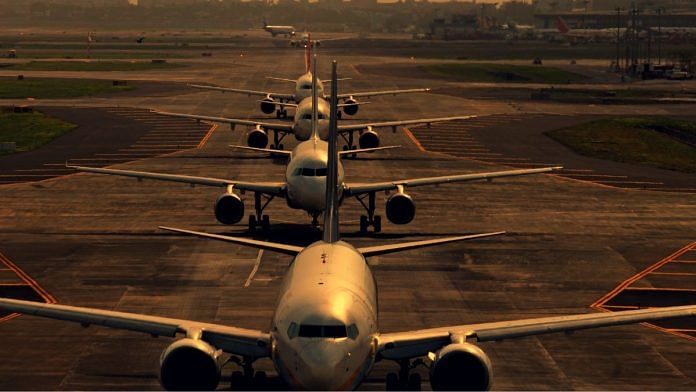New Delhi: International air cargo from India has seen a resurgence, with double-digit growth over the past year due to a spillover of sea cargo to air routes amid a crisis in the Red Sea since October 2023.
The crisis involves attacks on commercial vessels in the Red Sea, which channels roughly 30 percent of the global container traffic, amid the ongoing Middle East conflict. The seaborne cargo now travels a longer route via the Cape of Good Hope—which has benefitted the international air cargo traffic.
The air cargo growth slowed down 2022-23 onwards but surged in the second half of 2023-2024. From October 2023 to March 2024, air cargo volumes grew 18% year-on-year to nearly 1.7 million tonnes. The growth was 20% year-on-year from April 2024 to August 2024, with air cargo volumes growing to 0.967 million tonnes.
Even though air freight rates have increased by up to 300% in the past year, the Red Sea crisis has been making exporters choose air cargo for more and more products, such as smartphones, other electronics, and footwear, to ensure timely deliveries.
Overall, the Indian air cargo market size is at 3.36 million tonnes in FY2024. Of this, 60%, that is, 2.04 million, is driven by international cargo volume, Vinay Kumar G., the vice president and sector head of corporate ratings at ICRA Limited, told ThePrint.
According to the ICRA, India’s air cargo volume will likely witness a healthy 9-11% year-on-year growth, reaching 3.6-3.7 million tonnes in FY2025. This growth will likely get a further boost from an 11-13% year-on-year growth of international air cargo, also expected to reach new highs in FY2025.
“While the growth in cargo volumes has slowed down during the FY2023-H1 FY2024 period, it has bounced back handsomely in the last 12 months, since the start of the Red Sea crisis. The international cargo volumes have increased by 18% YoY and 20% YoY during 5M FY2025 and are expected to increase by a further 11%-13% YoY to touch new highs in FY2025,” Vinay Kumar G. said.
The director general at the trade body, Federation of Indian Export Organisations (FIEO), Ajay Sahai, said that the Red Sea crisis impacted the seaborne cargo destined for the Middle East and Europe, adding that air cargo is now partially plugging that gap.
Sahai said that amid the Red Sea crisis, which the currently breaking Iran-Israel conflict has further aggravated, most shipments are now travelling via the Cape of Good Hope, taking longer than before. Hence, many shipments are now pushed to the air mode to speed up the deliveries.
According to a World Bank blog, the volume of traffic through the strategic Suez Canal and Bab El-Mandeb Strait had dropped by half as of the end of March 2024, while the alternative route via the Cape of Good Hope route has witnessed a 100% increase in navigation.
“Since ships are now taking a longer route, shipping schedules have now become a little erratic, and many ships are also skipping Indian ports due timing constraints. So there is a movement towards air cargo,” he said.
However, he said that air cargo also has some constraints. There are supply-side challenges in air cargo since the country does not have many dedicated air freight services. Sahai said most cargo now travels in the belly of commercial, scheduled aircraft—which has limitations.
“If we compare freight costs from the pre-Red Sea crisis in October 2023 to now, the freight charges have gone up by 250-300%. Both sides (i.e., senders and receivers) are currently sharing the increased costs because this is something out of everyone’s control,” he added.
The World Bank has also noted that the Red Sea crisis has far-reaching implications for the shipping industry and, more significantly, the environment and the global economy. The longer routes necessitated by the current situation have increased travel distances for cargo and tankers by up to 53% and caused a rise in carbon dioxide emissions due to the additional fuel burned, the World Bank has warned. Additionally, from an economic perspective, the crisis has led to soaring freight rates and shipping insurance costs, contributing to inflation and negatively affecting regional and international shipping economies.
Sahai said that most smartphone exports are by air now, and other electronics are taking the air route, too. Earlier, footwear exports remained divided between air and ship, but that has now completely moved to air. Gems and jewellery always took the air route.
(Edited by Madhurita Goswami)
Also Read: Are flight bomb threats pranks or conspiracy? Cost of ‘hoax’ to Indian aviation is real




